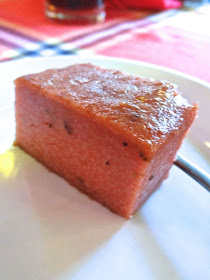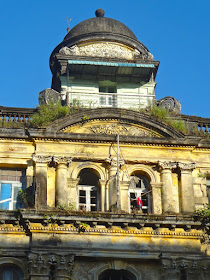The contrast of a golden Buddhist temples and modern European architecture standing side by side on the vast green expanse along the Yangon River earned the city the nickname "the garden city of the East." Yangon, formerly Rangoon, is the largest city in Myanmar. A mix of colonial architecture, modern high-rises and gilded Buddhist pagodas define its skyline. Even though it is no longer the nation's official capital, Yangon remains Myanmar's largest and most commercially important city. Although Yangon's infrastructure is largely undeveloped compared to those of other major cities in Southeast Asia, it has the largest number of colonial buildings in the region today, many of which are moss covered and in a state of anguished decay, due to its over 30 years of military dictatorship and pillaging of the nations wealth. However, with recent landslide election win by Nobel prize winner Aung San Suu Kyi's NLD party, the country seems on the brink of a brighter future. Without exception, everyone we spoke to in Myanmar were buoyed with optimism and commitment to Aung San Suu Kyi's vision for meaningful infrastructural reforms in all areas, particularly the economy, education and healthcare. We too are hopeful for their future and conscious of the exciting time we happened to be in Myanmar, bearing witness to this time of great change. The dawn of a new beginning.
With a private guide for the day, we explored many of Yangon's main sites, including the shimmering Sule Pagoda, which dominates Yangon's skyline and dates back over 2,000 years, the magnificent reclining Buddha at Chauk That Gyi, and Karaweik Hall, the 'hamsa-bird-shaped' floating barge on Royal Kandawgyi Lake. We strolled through the Scott's Market, also known as Bogyoke Aung San Market, with its hundreds of food, clothes, handicrafts and gems stores, then trundled off for a traditional Burmese lunch at a local restaurant. In the afternoon we were off to the Kaba Aye "World Peace" Pagoda and the Mahapasana Cave, site of where the sixth Buddhist synod took place; followed by Yangon's oldest Chinese temple and the riverside Botataung Pagoda, which holds three Buddha's relics, then onto Yangon's colonial quarter.
We concluded our day at the spectacular Shwedagon Pagoda at sunset, the most sacred and impressive site for the buddhist people of Myanmar. Gleaming in gold and decorated with diamonds, the huge Shwedagon Pagoda is a spectacular work of Burmese temple architecture and is the holiest Buddhist shrine in Myanmar. According to legend the pagoda is more than 2,500 years old dating back to the lifetime of the Buddha, making it the oldest pagoda in Burma. One of the wonders of the religious world, Shwedagon Pagoda, which consists of hundreds of colourful temples, stupas, and statues, is covered with gold and encrusted with over 4,000 diamonds and 3,000 other precious stones including rubies, emeralds and sapphires. At the very tip of the Shwedagon's spire sits a stunning 76 carat diamond, positioned to reflect the last rays of the setting sun. There is little wonder that the Shwedagon is referred to in Myanmar as "The crown of Burma."
Constructed in 1952, the Kaba Aye "World Peace" Pagoda, was built to commemorate the sixth Buddhist Synod which was held in maha Pasana Guha Cave in the same compound
The Kaba Aye Buddha
Buddha's tooth, the holy relic of the World Peace Pagoda
Ceiling detail in the pagoda
Reclining Buddha at Chauk That Gyi
Close up of the Buddha, complete with eyelashes
Markings on the soles of the feet represent the 108 auspicious signs of the Buddha
Burnt offerings left by pilgrims for Buddha
Mirror and coloured glass inlay on walls of the temple
A temple cat on the cool marble floor
Tradesman repairing column at the temple with bamboo scaffolding
for when he has to work at greater heights
Flower lady outside Chauk That Gyi, selling blooms for those wanting to leave gifts for Buddha
Street merchant selling fruit on the curb
The Orchid Restaurant in Yangon, where we stopped for a traditional Burmese lunch
Bronze sculpture with strands of fragrant jasmine flowers
The quaint interior with rattan furnishings and colourful wall paintings
Crisp tofu chips with pickled vegetables, dried shrimp sauce and sweet pork dip
Cold Myanmar lager brewed in Yangon
Cold smokey Eggplant Salad
Burmese Chicken and Vegetable Curry
Burmese Fish Curry
Sticky Rice kept warm in a traditional bamboo basket
Sticky white jasmine rice, a local favourite
Sautéed Morning Glory and Local Mushrooms
A dessert of fried banana and sliced cold watermelon
Local sweet coconut cake
Yangon harbour with small barges that ferry workers who commute from the city to Dalah,
a poor community across the Yangon River
Harbour workers hauling bags of rice along the pier to waiting trucks
Botataung Pagoda, located in downtown Yangonnear the Yangon river, was first built by the Mon around the same time as was Shwedagon Pagoda, over 2500 years ago and houses what is believed to be a sacred hair of Gautama Buddha
Temple spire detail of sacred bird
The walls of the temple are covered in gold leaf
An architectural reminder of Yangon's colonial past when occupied by the British
Now covered with moss and overgrown with ferns, a stately building in Yangons colonial quarter
Once a handsome building during colonial times, it's now home to squatters
Built in 1901, the Strand Hotel was once one of Southeast Asia’s grand colonial hotels
Yangon City Hall
A street merchant selling betel leaves, potent parcels of areca nuts, lime and tobacco, that once chewed produce a mild buzz and bright red teeth among heavy users!
Preparing the betel leaves
Clementime merchant at Scott Market with Thanaka on her face,
a creamy paste used by Burmese women to protect their skin
Thanaka is made by grinding sandalwood with water on sandstone to produce a paste
A street merchant making Mont Lin Ma Yar, roughly translated as “husband and wife snacks,” made by pouring dollops of rice flour batter into a large sizzling cast iron pan then topped with quails eggs
Buddhist novice nuns in pink robes, chanting for alms from Scott Market merchants and shoppers
Woodcarved panels at Scott Market
In the middle of Yangon, Sule Pagoda dominates the skyline at night as it's illuminated for all to see
Sule Pagoda
Shwedegon Pagoda
Shwedagon detail
An arc of shrines surround the pagoda
As night falls, the pagoda and surrounding temples light up to create a breathtaking sight
Lanterns are lit in an arc around the gold chedi
The Shwedagon temple crowned by a full moon
According to legend the pagoda is more than 2,500 years old dating back to the lifetime of the Buddha, making it the oldest pagoda in Burma
Crowned with a 76-carat diamond and studded with thousands of precious stones, the gems are positioned to reflect the last rays of the setting sun























































No comments:
Post a Comment